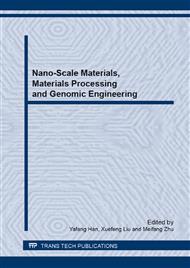[1]
Xiaoyong Yin, Microscopic research on the diffusion coefficient. Tianjin university doctoral dissertation, 2007.
Google Scholar
[2]
Qiuya Zhai, Jinfeng Xu, Sen Yuan. Formation Mechanism of the Austenite Shell around Nodular Graphite in the Hypereuectic Nodular Iron. Foundry 2001; 50: 376-80
Google Scholar
[3]
Pauls G.Shewmon, Diffusion in Solids, New York: Minerals, Metals, & Materials Society; 1963.
Google Scholar
[4]
S.Darken, Physical Chemistry of Metals, New York: McGraw Hill; 1953: 453.
Google Scholar
[5]
J.Crank. Methematical of Diffusion, Lawn: Oxford University Press; 1975: 252.
Google Scholar
[6]
J. Parlossoglou, HTM. 1979; 34, 1-14.
Google Scholar
[7]
Yeqiong Wu, Mufu Yan, Liyan Zhao. First Principles Study on Effect of Lanthanum on Diffusion of Carbon in γ–Fe Crystal Cell, Ninth National Heat Treatment Conference Proceedings September, 2007; Dalian.
Google Scholar
[8]
(Japan) Zhang Bo, Mingzhiqingming, Gaojiansan, Basic, Theory and Application of Nodular Cast Iron, Beijing: Mechanical Industry Press; 1983.
Google Scholar
[9]
S. Chang, D. shangguan, D. M. Stefanescu, Prediction of microstructural evolution in SG Cast iron from solidification to room temperature, J AFS Transactions 1999; 91: 531-41.
Google Scholar
[10]
Baicheng Liu, Haidong Zhao, W. Y. Liu, D. T. Wang, The 6th symposium on science and processing cast iron.Sep.28-Oct.7 1988; Birmingham, USA.
Google Scholar
[11]
J. Liu, R. Elliontt, Numerical modeling of solidification of ductile iron, Journal of Crystal Growth 1998; 191: 261-7.
Google Scholar
[12]
D.K. Banerjee, D.M. Stefanescu, Structural transitions and solidification kinetics of SG cast iron during directional solidification experiment, [N] AFS Transactions.
Google Scholar
[13]
S. E. Wetterfall, H. Fredriksson, M. Hillet. Solidification process of nodular cast iron, JISI 1972; 210(5): 323-33.
Google Scholar
[14]
Zongchang Liu, Huiping Ren, Haiyan Wang. Austenite formation and pearlite transformation, Beijing: Metallurgical Industry Press; 2010.
Google Scholar
[15]
G. Lesoult, M. czstro, J. lacaze. Sollidification of spheroidal graphite cast iron-physical modeling, J Acta meter 1998; 46(3): 983-95.
DOI: 10.1016/s1359-6454(97)00281-4
Google Scholar
[16]
Haidong Zhao, Baicheng Liu. Simulation of microstructure formation of spheroidal graphite iron casting. International journal of cast metals research 2003; 16:1-3.
DOI: 10.1080/13640461.2003.11819596
Google Scholar


